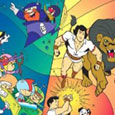Hanna-Barbera (1967), Warner Home Video (July 17, 2007), 2 discs, 420 mins plus supplements, 1.33:1 original full frame ratio, Dolby Digital Mono, Not Rated, Retail: $26.98
Storyboard:
A winged hero takes on the forces of bad-ness, plus three people from different planets protect the galaxy from various threats.
The Sweatbox Review:
Space Ghost was a big hit for Hanna-Barbera in 1966, which was the dawning of the legendary Saturday morning era of greatness. Naturally, this led to the development of a slew of other action-adventure shows from the studio as well as others, with the television networks wanting to do whatever clicked with audiences of the time. No doubt the resurgence of interest in comic book heroes, spurned by the success of TV’s Batman and the emergence of Marvel Comics the past few years, played a role in the development of such shows as well. On CBS, aside from continuing with Space Ghost, Hanna-Barbera added Herculoids, Shazzan, and Moby Dick And The Mighty Mightor. They also did their Fantastic Four cartoon in 1967 for ABC (who also debuted Spider-Man that year), while NBC got H-B’s Birdman.
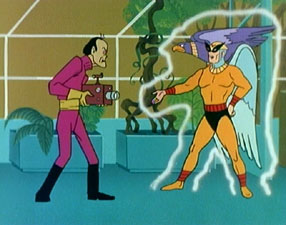
Like the other H-B adventure shows of the 1960s, Birdman had designs by Alex Toth, which made all the shows look consistent in their approach. Toth set the standard back then for what adventure cartoons should look like, with his work carrying on into the 1970s and beyond with such series as Super Friends. For many of us, the Toth shows defined what we loved about Saturday morning cartoons. Heroes posed elegantly, and did dynamic things in ways that seemed just so “right.” Such a revolution in television cartoons would not be seen (arguably) until Bruce Timm redefined the genre with his designs for Batman: The Animated Series in the 1990s. Of course, anyone who has seen the Toth shows can tell you that while they often look great, they also did have to rely on the skills of the animators to make the cartoons really soar, which is where inconsistency crept in. This was occasionally a problem on Space Ghost, but became more noticeable as Hanna-Barbera vastly expanded their superhero offerings in 1967 and only had so many artists who were truly comfortable with the material. Backgrounds also saw some corners cut on Birdman, with cityscape renderings that could charitably called minimalist.
Nevertheless, the visual excellence still shines through enough to make watching Birdman almost as much of a treat as Space Ghost. The format of the two shows was the same, with Birdman receiving two seven-minute segments (the show’s opening sequence had only his name), with another totally unrelated cartoon in the middle. Birdman featured the adventures of a winged superhero who got his powers from the Egyptian sun god Ra, and the powers would fade when he was out of sunlight for a short time. These powers included flight, strength, and the ability to fire solar beams from his hand, as well as to create a solar shield. The wings were not the only distinctive element of his design, as he also had a unique mask and other interesting costume elements such as a crest on his forehead and a pleasing color scheme that allowed a grown man to look good in a mostly yellow body suit. His base of operations was in an extinct volcano, which rivaled the Batcave for coolness. Inside the volcano, he monitored the Earth for trouble, and received orders from Falcon-7, an eye-patched contact with the Inter-Nation Security agency.

Often, Falcon-7 would send Birdman out to foil the plans of F.E.A.R. (pronounced F-E-A-R to ensure the kids knew it was an acronym), an international criminal and terrorist outfit. There were plenty of other bad guys to fight, however. They included Cumulus The Storm King, Mentok The Mind Taker, The Brian Thief, and Reducto. Most of the villains appeared only in one episode, with few exceptions (Vulturo, Dr. Millennium). Even the leader of F.E.A.R. appears only four times. Birdman had a giant purple eagle named Avenger to help him, and fortunately the writers avoided using Avenger for any cheesy comic relief, with the show maintaining a serious tone. Later on, Birdman took on a protégé named Birdboy, whom he had saved at sea; Birdman transferred some of his powers to the lad while reviving him with solar radiation. From his mentor, Birdboy took on the annoying habit of calling out his own name while taking off in flight. One episode also had a Birdgirl, although she was just a pawn of another villain and never appeared again.

As audiences found out on Space Ghost, only so much plot can go into seven minutes, so consequently the stories are pretty straightforward superhero stories. And, with most villains lasting only for one story, you never got to know Birdman’s adversaries very well. Even Birdman himself remained pretty much a cipher, never receiving an origin story or much real characterization. No, these stories were all about seeing the hero beat the bad guy, and that’s about it. The lack of multiple appearances by villains actually works in the show’s favor when watching numerous episodes in a row, as the constant barrage of new threats maintains one’s interest even if the stories themselves are pretty light on plot. There’s plenty of action, too, in a Hanna-Barbera limited animation kind of way. Of course, it was all that action and violence seen in this show and others that led to a backlash against superhero shows by concerned parent groups. In fact, the very next season saw very little in the way of new superhero shows, with only Batman getting a new cartoon (teamed with Superman in a one-hour show) based on the popularity of his live action series. Spider-Man also got another season, and shows like Fantastic Four and Birdman went into reruns, but then the superhero shows pretty much vanished from Saturday mornings. The closest thing to superheroes on Saturday mornings in 1970 was The Harlem Globetrotters! The next wave of superhero programs would be tamer than what appeared in the 1960s, starting with the very gentle first season of Super Friends in 1973.

The other segment on Birdman was The Galaxy Trio, comprised of Vapor Man (who could turn himself and other materials into various useful vapors), Meteor Man (who could grow parts or all of his body and utilize tremendous strength), and Gravity Girl (who could control the weight of herself or other objects). The three formed a miniature Legion Of Super Heroes, using their native-born abilities to fight crime throughout the galaxy either on their own or working with the Galactic Patrol. Their adventures were diverse and took them to many different worlds, as they combated Rock Men, Demon Raiders, Sporoids, Duplitrons, and other assorted wild-sounding challenges. Their stories stack up well against similar types of adventures to be found in classic Silver Age comic books. Like Birdman, their stories were done quite seriously despite some outlandish settings and threats.
Whether watching Birdman or The Galaxy Trio during the twenty episodes included on the DVD set, you are enjoying a part of Saturday morning history. Once those anti-violence busybodies got their way, high adventure would be hard to come by for the next few years on Saturday mornings; but for just a couple of years there, adventure ruled Saturday mornings, and this show was a typical example of how much fun that could be. It may not have a great deal of depth, and the excellent design work is sometimes hampered by inferior animation artists, but Birdman & The Galaxy Trio delivers when it comes to exciting the imagination.
Is This Thing Loaded?
Birdman: The Forgotten Hero (10:08) is the only true extra on the set. Ironically, it opens with commentary from Michael Ouwleen, whose spoof show Harvey Birdman: Attorney At Law brought the character to new lows (although in a hilarious way). He doesn’t tell us much more than what we could have gathered from watching the show itself, but he does come loaded up with some fantastic Toth model sheets. Add in brief interviews with a couple of artists who worked on the show and you get a pleasing though not in-depth featurette.
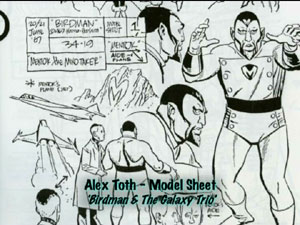
The Trailers here are for Wait Till Your Father Gets Home, Space Ghost/Birdman/Droopy, Ben 10 and Popeye.
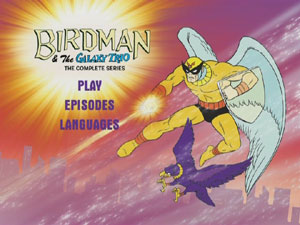
Case Study:
Warner may not go as all-out on special features as BCI, but they do know how to make an attractive package for their animation collections. The Space Ghost and Birdman releases share a common cover design, with a new space-oriented background for the Hanna-Barbera Classic Collection banner. Birdman gets the front cover and interior of the digipack to himself, while The Galaxy Trio are alone on the back cover of the slipcase and both covers of the digipack (the same arrangement as with Space Ghost and Dino Boy on their set.) The digipack has overlapping double-sided discs on one side of the interior, and episode listings on the back cover and the left side of the interior.
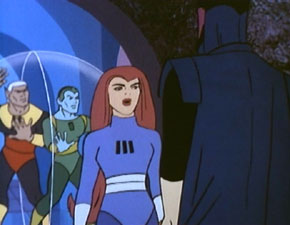
Ink And Paint:
Birdman has seen better days, unfortunately. The word “remastered” appears nowhere on the package, and the results are plain to see. The episodes are grainy and show frequent physical artefacts, though the compression work is fairly good at least. Colors show minimal fading, but of course the usual blemishes appear (smudges, dust) that are to be expected with cel-animated programs. Bands appear on the sides of the image at all times, and there are relatively frequent signs of wear on the source elements.
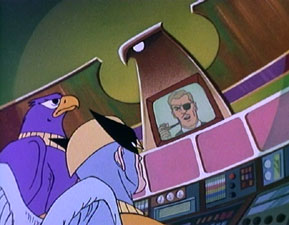
Scratch Tracks:
The original mono is preserved in the center channel, sounding probably as good as it did in 1967. There is not a whole lot of force or dynamic range in the track, but it gets the job done satisfactorily. English subtitles for the hearing impaired are also included.
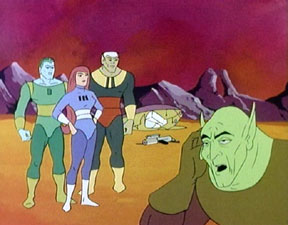
Final Cut:
One doesn’t recommend a show like this because it was particularly groundbreaking or because of unusually strong writing or animation. This is just a frequently great-looking show with fun stories from the golden age of Saturday mornings. The video and audio show their age, but the stories hold up well in their entertainment value. The featurette is a nice touch, and the package is very nice. Fans of this era should enjoy seeing Birdman & The Galaxy Trio, thanks to some classic design work and imaginative fantasy and science fiction stories.
 | ||
 |








